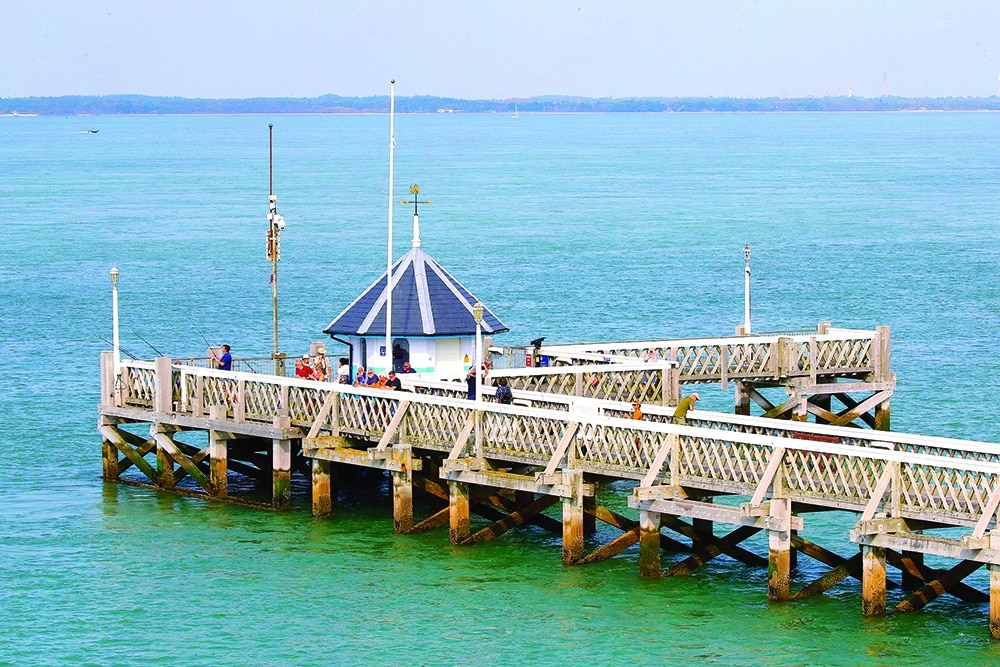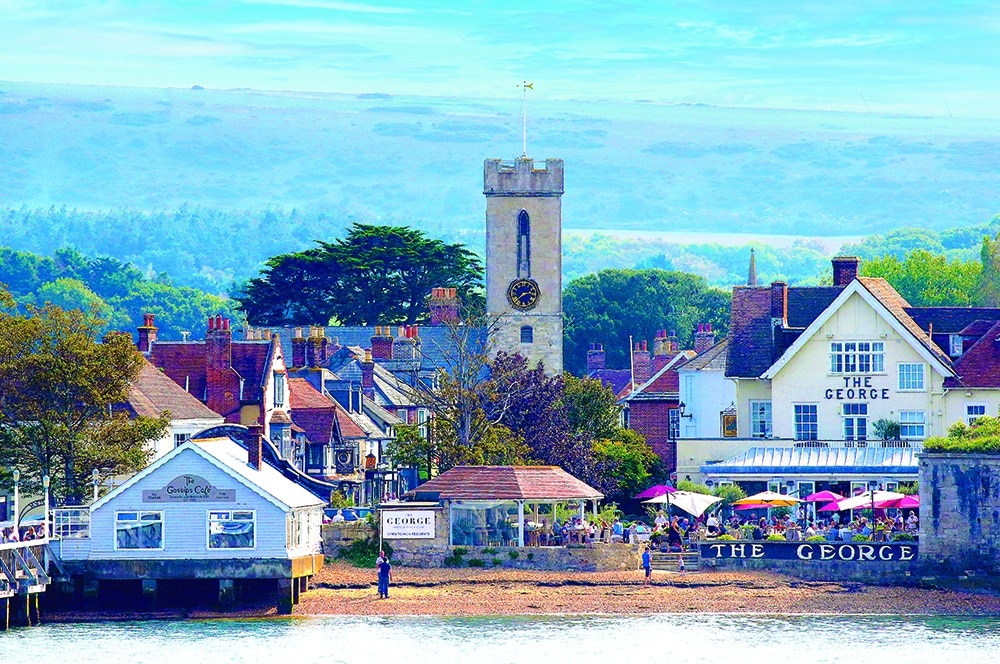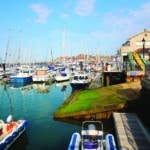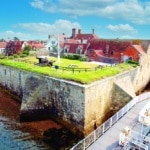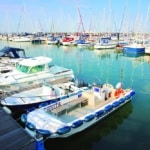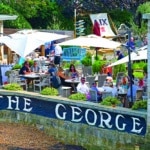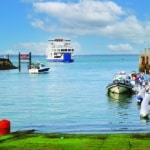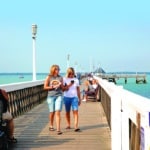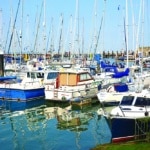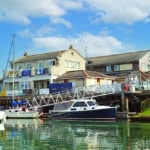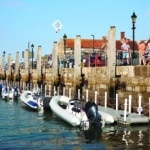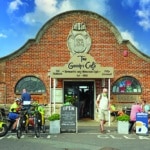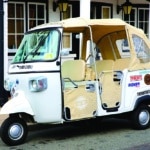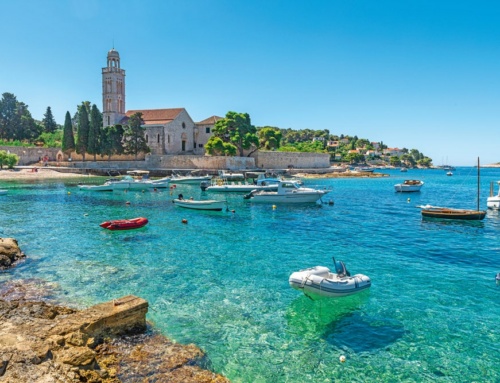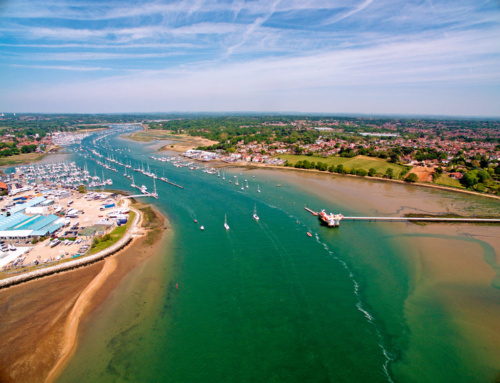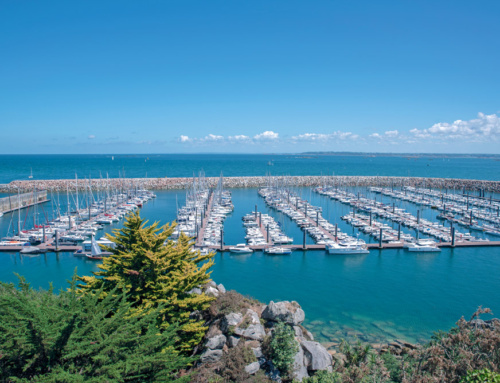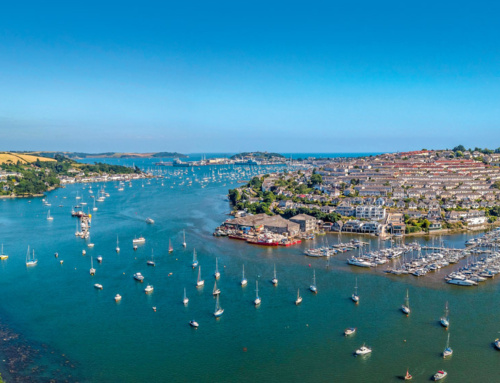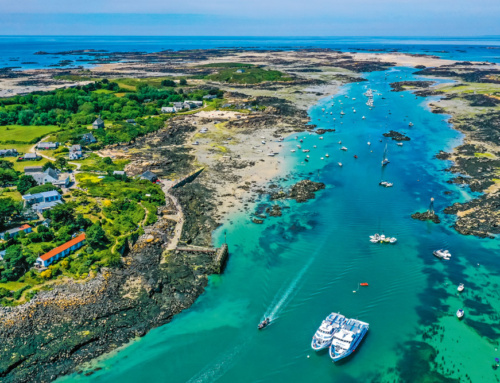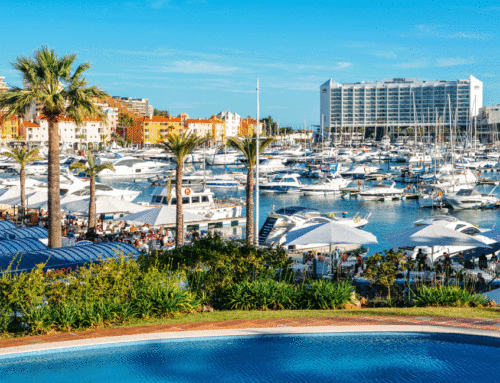Alex Whittaker visits this small but perfectly formed harbour, right on the Solent …
Yarmouth is located to the north-west of the Isle of Wight on the River Yar. It is a pretty town and lies just a short passage across the Solent from equally appealing Lymington. Yarmouth is a historic port town. It is the site of one of Henry VIII’s 16th-century artillery forts and has long been a famous yachting destination. The recent addition of a modern pontooned marina within its old harbour walls has only added to its popularity. Most conveniently for powerboaters, the harbour and town are immediately adjacent.
Approach from sea
Yarmouth is easily spotted against the Isle of Wight hinterland with its long wooden pier and its distinctive, tall and majestically be-clocked church tower. The only off-lying hazards are Black Rock, clearly marked with a green conical buoy (flashing green, 5 seconds), and the shoals that lie north of the pier. The unusual pier has a dog-leg but lies roughly east-west. The constant buzzing of ferries and small craft offers another set of entry clues to the keen pilot. After dark, the ferry terminal is floodlit, and the pier has its own lights. Yarmouth Harbour entrance waypoint is 50 42 42 North, 01 30 05 West.
Tidal set
The tide sets strongly across the harbour mouth at half-flood and ebb. If you are not mindful of this fact, you risk being swept either side of the quite narrow harbour entrance. In essence, one should keep 50 metres clear of the pier head and its fishing lines, which lie to port, and pick up the harbour leading marks 187 degrees true on the quay. The approach channel is maintained to a depth of 2.5 metres below chart datum. Naturally, pleasure craft must give way to the ferry. Generally, this means keeping well to starboard of the ferry slip, and towards the harbour wall. The harbour speed limit is 4 knots. A berthing master will come out to assist you if you have previously radioed ahead on Channel 68. Incidentally, Yarmouth Harbour offers its own (highly recommended) online pictorial harbour approach and entry guide: https://www.yarmouth-harbour.co.uk/harbour-entry-fullscreen.php
Rafting up
Never forget that Yarmouth is extremely popular in high summer, so booking ahead is essential. Indeed, over busy summer weekends, ‘Harbour Full’ signs are often posted on the end of the ferry terminal. Rafting up is commonplace too. Also, arriving crews must be prepared to moor up port or starboard to. The new marina has 220 visitor moorings – these include floating pontoons with direct walk-ashore access, those that will require your dinghy and the harbour taxi (Channel 15 VHF, mobile: 07969 840172). The harbour is an exciting and busy place in high summer, with a lot going on.
- Slipway near Yarmouth Sailing Club – harbour building and town beyond.
- Henry VIII’s chunky artillery fort at Yarmouth.
- Yarmouth offers over 200 berths.
The ferry
If you are towing your powerboat or RIB overland to Yarmouth, you will need to catch the ferry from Lymington. First of all, let me pay tribute to the ferry staff ashore and aboard. They were extremely helpful, even under trying COVID circumstances – especially when I got in a tussle with the truculent robot ticketing system. The Lymington ferry car park is vast. It is deliciously easy to manoeuvre your boat and tow vehicle straight through the helpful lane system – great customer support. The ferry terminal’s riverside snack bar staff were similarly cheerful and helpful. You can sit outside in the sun awaiting your ferry and enjoy something to sip or nibble. All this makes the ferry experience quite an event, like a mini Channel crossing. It’s only a short passage to Yarmouth, at let’s say … ahem … a leisurely pace. Still, you get the chance to visit the ship’s bar, eat a nice sandwich, and giggle at the amusing and wry remarks from the Captain. Most importantly, you can have a good gander up and down the Solent from on high as the ‘cruise’ unfolds. The fab open top deck gives a truly commanding view.
The final approach to Yarmouth is both compact and spectacular, arriving next to the castle and the ferry slip in a bold theatrical setting. Incidentally, if you keep your eyes open on the ferry’s top deck, you can easily learn the safe approach to Yarmouth Harbour, as it opens up far below – ideal for the visiting skipper to get her or his initial bearings. Following the ferry at a safe distance into harbour was clearly the normal thing for many local small craft. Staying well behind the ferry on the rear starboard quarter was their preferred approach. These craft then gently swept to starboard, as the ferry berthed, to access the harbour proper. This approach gives access to the all-important fuel berth and the first marina pontoons. Obviously, with this large ferry running night and day, one has to pay close attention to its manoeuvrings when in the harbour environs. Give this ship loads of room.
Harbour reception
This versatile building, right on the quay with its own car park, is the hub of all harbour operations and services. It houses the harbour master and reception facilities and ‘Cockpit Essentials’. This is a nifty initiative encompassing toilets, showers, launderette, gift shop, coffee lounge, refreshments, tourist information and mobile charging. It also has a 24-hour news facility, and even Calor Gas and Campingaz sales. Just note that the toilets and showers do not have 24-hour availability – times are posted. For crewmembers with reduced mobility, disabled access to the building and the shower and toilet facilities has been ensured. This is always gratifying to see. There are baby changing facilities, and even ice is on sale for your crafty back-deck G&T. Free Wi-Fi is available too, though we did not try it beyond googling and reading emails. Although the nearest cash dispenser is in town, there is cashback available at Cockpit Essentials – a useful backup. Mind you, all our purchases in Yarmouth town and the harbour were via card. We found the harbour facilities met all our essential needs as visiting boaters in a pleasant environment. Cockpit Essentials does not feel like a marina reception – more like a mini seaside facility, with a holiday atmosphere.
- The George’s seaside beer garden.
- The harbour entrance from the main slipway, with ferry arriving.
- The restored and rather fine Yarmouth wooden pier.
Tidal flow
The tidal flow within the harbour and its entrance can be strong. These currents can cross berths at odd angles.
Slipway
The main slipway is right by the Town Quay wall. This is conveniently close to the car and trailer parking. It is wide and easy to use. Fees are payable at reception. There is another slipway by Yarmouth Sailing Club, and this is often full of happy families crabbing. Family crabbing is most certainly not frowned upon at Yarmouth, but it is sensibly restricted to this much safer area. The kids loved it.
Cranage
A crane is situated on West Quay. Its SWL is 5 tonnes. Charges apply, and the crane is operated for you by a YHC staff member.
RNLI berth
The Yarmouth Lifeboat is based in the harbour. One has to be aware that she might sally forth at any time, day or night.
Water
You will need your own hose, but water is available on South Quay, Town Quay and at the fuel berth.
Marine businesses
Yarmouth Harbour seems to have the full complement of marine businesses. The Yarmouth harbour website lists them all. We felt Yarmouth would be a great cruising base for a full season’s foray along the Solent, but we would certainly have to book early!
Chandlery
There is no chandlery at the harbour, though you can get gas. The nearest chandlery is Harwoods in The Square (01983 760258). It is very Traditional.
- Busy, busy, busy. The moral is book early.
- Yarmouth Harbour reception.
- The slipway by Yarmouth Sailing Club. Use the other one by the Town Quay.
Fuel
We were delighted to find that both diesel and unleaded petrol were available at the fuel berth. Boats may use both sides of the pontoon. There is also a free waste pump-out. Call Channel 68 for these services.
Recycling
The harbour provides comprehensive recycling facilities.
Yar Bridge
To transit the Yar Bridge upstream to access Yar Boatyard and the river moorings, one must call ‘Yar Bridge’ on VHF Channel 68. In BST, the fixed opening times are:
0800, 0900, 1000, 1200, 1400, 1600, 1730, 1830 and 2000. In GMT, the bridge opens on request. The traffic light system operates as follows:
- Red = STOP
- Red and Green = STAND BY
- Green = GO
Swimming area
Yarmouth Harbour has also provided two more quite unexpected features. First, beyond the bridge is a protected swimming area, which is very popular on hot days.
BBQ area
The second surprising feature was the provision of a defined BBQ area. Boaters can buy disposable BBQs from the harbour’s main reception building. A nice touch, we thought. The provision of waste bins was a thoughtful addition.
Royal Solent Yacht Club
This is next to the pier and welcomes visiting boating people. Its bar has unrivalled views over the Western Solent. Your RYA card, or another affiliated boating club card, will do the trick.
Cycling
Bike hire is available at Wight Cycle Hire at Yarmouth Station (01983 7611800). We were delighted to discover that there is a bike route from Yarmouth to that hallowed boating location, the Needles.
On the town
So, how to describe neat little Yarmouth town? Well, it is authentically historic, well kept, very pretty and very friendly. The wooden pier is an utter delight, as are Henry VIII’s castle and the square-towered church – continuity, not cosmetics. The main street is picture-perfect southern England, and the narrow back streets and alleyways are full of things to discover. It is a gentle place, both relaxed and relaxing. When we were there, we were bothered by very little road traffic. True, there were one or two cute and rather fashionable little tuk-tuks to take you about; however, we sauntered in the hot sunshine like lords. We liked the welcoming pubs and the full range of dining opportunities afforded by the town. The continuum ranged from quite posh and formal right through to fun fish ’n’ chips. Venues included the rather good George Hotel (and Beach Club) and equally interesting but crucial modern eateries like On the Rocks and Salty’s.
Yarmouth’s shops, mostly individually owned, have deftly avoided high street clone blight. They provide the visitor with a refreshing variety of interesting things to explore, buy and take home. We looked at everything from gemstones to fossils, country crafts to chandlery. There were adequate opportunities for revictualling (including ‘licensed’) and there was even a cash dispenser. Overall, this is a great place to idle away, doing nothing in particular, after a few pints. ‘People watching’ in the George garden is a great delight. If you truly love boats and boating, Yarmouth, Isle of Wight, is one of the sacred destinations.
- Yarmouth’s only waterside cafe, The Gossips.
- The Bugle Coaching Inn is very alluring.
- Fashionable little tuk-tuk on the streets of Yarmouth.
Ten fun facts about Yarmouth
- Yarmouth has been a settlement for over a thousand years.
- Yarmouth is the second-smallest town in England.
- The Danegeld tax of 991 mentions Yarmouth.
- Eremue was the settlement’s original name, meaning ‘muddy estuary’.
- The French burnt down the town in 1544.
- As an angry response, Henry VIII built Yarmouth Castle in 1547.
- In 1784, many of Yarmouth’s ancient charters were stolen by a drunken sea captain.
- Yarmouth was a corrupt Parliamentary ‘rotten borough’ for a quarter of a millennium.
- Yarmouth Pier, at 186 metres (609 feet), is the longest wooden pier in the UK with public access.
- Pamela Green, 1960s glamour model, and doyenne of the modern ‘top-shelf industry’, lived in Yarmouth.
The whole Solent, the Channel Islands and northern France become your oyster! However, below are a few much closer places you might visit by boat from Yarmouth:
The Hut at Colwell Bay, IoW
There is a highly recommended beach restaurant at Colwell Bay, well known for its stunning sunsets. Anchor up and they will bring you ashore in a RIB.
Alum Bay, IoW
This famous anchorage overlooks the Needles. It’s renowned for its swimming.
Newtown Creek, IoW
A superb anchorage within a nature reserve. Take your tender and a picnic ashore to enjoy the beach.
Cowes, IoW
As famous as it gets. Also, take time to take your tender to the Folly Inn about 2 miles further up the River Medina.
Hurst Castle
This landmark close to Lymington River has an open anchorage, but be careful of the strong tidal current alongside the beach. Good lunch stop.
Beaulieu River
Beaulieu is a stunning destination by boat. Tranquil and riparian. Tie up to one of the river moorings at the village or venture to nearby historic Buckler’s Hard.
Cruising further (with approximate sea mileages):
- Christchurch 18nm
- Poole Harbour 25nm
- Studland Bay 21nm
- Southampton Water 20nm
- Hamble River 16nm
- Portsmouth 23nm
- Bembridge 24nm
- Chichester Harbour 32nm
Access
By road
Road access is via Lymington on the mainland. Exit the M27 at Junction 1, following signs for Lymington on the A337.
At Lymington, the marina directions are indicated by brown tourist signs – initially as Marinas & Riverside, and then as Yacht Haven. By exiting the M27 at Junction 2, you can reach Lymington via Beaulieu, avoiding the potential bottleneck at Lyndhurst during the busy season. Your mainland target is the Lymington Ferry Terminal.
By rail
There is a regular half-hourly service from the main line station of Brockenhurst through to Lymington Town.
By air
Both Southampton and Bournemouth International Airports are within easy reach – just a 40-minute drive from Lymington. It’s around a 1.5- to 2-hour drive from London Heathrow and Gatwick.
Yarmouth Bus Station / Taxi Rank
These lie immediately adjacent to the harbour car park. Very convenient.
Contact
Harbour master: 01983 760321
VHF Channel 68668
Water taxi: 07969 840173 VHF Channel 15
https://www.yarmouth-harbour.co.uk/
Charts
Admiralty:
SC5600
2021
2035
Imray:
C3
C15
2200
Stanfords:
11
Chart packs 24 and 25
L9
L10
